
by Coach Adolfo Salgueiro | Jul 13, 2021 | Book Review
By Dean Karnazes
Reviewed by: Coach Adolfo Salgueiro
Since the unexpected success of his first book, Ultramarathon Man, back in March 2005, Dean Karnnzes has become a running celebrity. His superhuman feats of endurance and adventure have inspired thousands of ex-runners to lace up their shoes once again, and new ones to start pounding the asphalt for the very first time.

This book is a good investment in time and money
In “A Runners High”, Karnazes tells a variety of running stories interlaced with his preparation and participation in the 2019 edition of the Western States Endurance Run. This is a 100-Mile race that has become the Boston Marathon equivalent of the ultrarunning world. It takes place in the California Sierra Nevada during the last weekend of June. It ran for the first time in 1977.
The narrative starts with Karnazes preparing to run the Bishop High Sierra Ultramarathon, a 100K race in preparation for his eventual participation in the Western States, where the narration culminates. In the meantime, there are many first-person accounts and running stories that, even if many runners can’t relate, they are told in such a quotidian, non-technical, well described and no aggrandizing way, that if you have run for a few years, you will be able to visualize, identify and even feel the glory and the suffering of the storyteller.
The author also delves into the dynamics of his family and their intersection with his demanding running career and life. His son Nicholas and his parents, as well as their interactions, become important figures in the narration. As a runner, son, and father, I can definitely identify with many of those situations. His wife and daughter also made important appearances, but to a lesser degree.
As the weeks pass by and events take course during the span of a few months, some of Karnazes latest running adventures, the ones that haven’t made it to his previous books, make an appearance. His running of the Silk Road through Uzbekistan, Kazakhstan and Kyrgyzstan is the story I liked the best. It shows how running can become part of US diplomacy. It also takes you through some of the roads least traveled by every-day US citizens. His interaction with the locals and their customs is well told though very illustrative anecdotes.
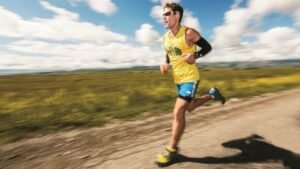
“We discover who we are through the movement of our bodies” – Dean Karnazes
Then, of course, it comes Western States, where the whole gamut of human emotions show up at one point or another. From euphoria to misery, and everything in between, take their turn as part of the racing experience. Through these emotions, he masterfully takes the reader through the understanding of the peaks and valleys of ultrarunning, even if he/she has never ventured beyond the thin line that separated “regular” running from ultrarunning.
Not sure if it was the vivid description of the misery he went through or that I don’t feel like the Western States are in my future, but the one thing I can say about this Karnazes book when comparted to his previous ones (which I’ve read them all), is that after finishing this one I didn’t feel the rush to lace up my shoes and go for a long run. Somehow, this experience was not relatable to me, while his other ones, while are not in my future either, were. But that is not a judgment on the book’s value, just a personal assessment.
As usual, Karnazes comes up sometimes with marvelous nuggets of running wisdom that become some of the most quoted in running. This one is the one that blew my mind; thus, I share:
“Running is a conversation, and education, a revolution, an awakening. We discover who we are through the movement of our bodies, and there are lessons to be learned in running alone much as there are in running large races”.
This is a good running book that most runners will enjoy and somehow relate. Entertaining, well-written, funny at times and deep at others without leaving you gloomy or mentally exhausted. A good investment of time and money.
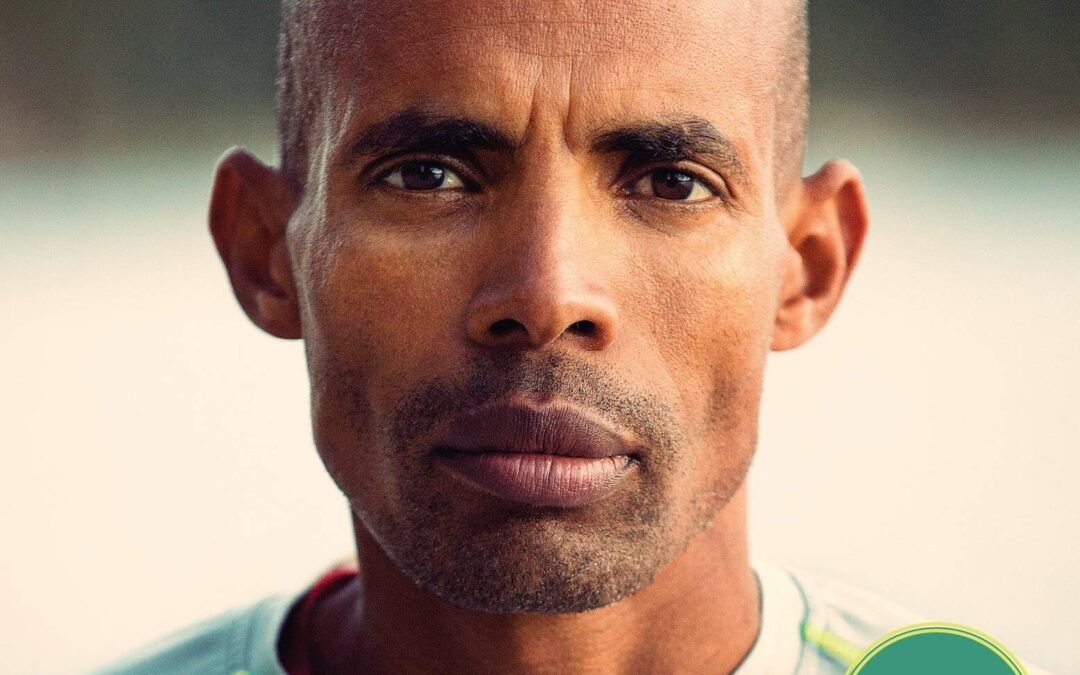
by Coach Adolfo Salgueiro | Feb 9, 2021 | Book Review, Opinion
By Meb Keflezighi (With Scott Douglas)
Reviewed by Coach Adolfo Salgueiro
When we talk about the top US marathoners in the United States during the first fifth of the 20th Century, the name of Meb Keflezighi automatically jumps to the forefront. If you don’t consider him at the top of the list, which you are entitled to, it seems difficult he won’t be on your Top-3 or Top-5. He is the only runner to ever win Boston, New York and earn an Olympic medal. And even though he only won 3 of his 26 career marathons (hence the name of the book), his personality, constant top-level performances and contagious smile, made him an icon on the world stage between 2002-2017.
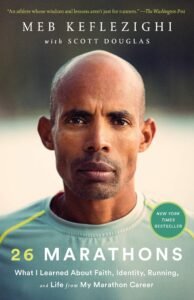
A good book, well written and worth the time and the money
In his latest book, Keflezighi goes into detail about each one his 26 marathons. How he trained, what were his life challenges at the time, how he performed and the sports and life lessons he took from each one of them. He enjoys and doesn’t shy away from the glory of his successes, yet at the same time makes himself vulnerable by taking us through his failures and how to deal with them when you are expected to perform at a certain level and you just can’t.
This is a short book, about 250 pages, and a very pleasant read. Succinct chapters allow you to soak in a marathon or two in each sitting, without being overwhelmed by excessive details.
At times it becomes difficult to relate to Meb’s running experiences because 99.9% of runners will never need to ponder if we are ready to respond to Eliud Kipchoge’s surge in the Olympics or how to prepare for what may come to us in the last 10K of the New York City Marathon when you enter First Avenue as part of the leading pack. But that doesn’t matter. We read books about great baseball or football players though we will never be on the field with them at the next World Series or Super Bowl. Meb’s tales from the front are well told and through his words, he does bring us with him to that place we will only see when we are watching a race on TV.
The book is geared towards life lessons on planning, patience, adjustment to goals, change of expectations made on the fly and many other subjects that mean something to us when they come from first-hand experiences from a world-class athlete who has been there not one, but many times.
A leitmotif for Meb’s career was his spouse’s support. He doesn’t hide that his wife, Yordanos, was the family’s backbone that permitted him to achieve his goals. As runners, we all need the support of our wives, husbands or significant-others to achieve what we are looking for, and the Keflezighis show us how.
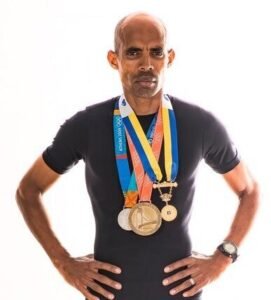
Only athlete ever to win Boston, New York and an Olympic medal
I loved Meb’s conclusion about his career as a marathoner. We may not be able to relate to some of his tales from the leading pack, but everyone who has completed multiple marathons, somehow will see himself/herself in this:
“I did twenty-six marathons over fifteen years, one for each mile of the race. I learned that the marathon can hate you or love you. It can make you go though misery or experience great joy. I learned that no matter what it happens, eventually you’ll look back and think, ‘That was a beautiful thing. I’m glad I did it.”
If you want to know more about Meb’s personal life, his childhood in Eritrea, move to the United States, life and career, “Run to Win” is your book. “26 marathons” is a good book, well written and worth the time and the money you will spend on it. But I do think it is important to understand what the book is and what it is not, before you tackle it, so you can be in the right frame of mind when you read it and thus, get the most out of it.
If anyone knows or has access to Meb, please thank him on my behalf for both books and for being an inspiration to the running community throughout his long career. His name is up there with Alberto Salazar, Bill Rodgers, Frank Shorter, Ryan Hall, Clarence De Mar, etc. in the pantheon of great US runners of all time.
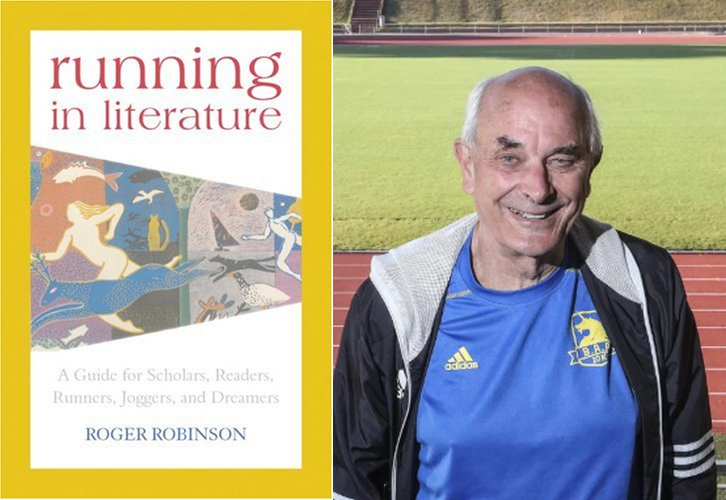
by Coach Adolfo Salgueiro | Oct 20, 2020 | Book Review, Opinion
Written by Roger Robinson
Reviewed by Coach Adolfo Salgueiro
As explained in detail in Born to Run, the 2011 masterpiece by Christopher McDougall, the human body was designed to run. Not for sport, not for pleasure but for survival of the species. So it can’t be a surprise when we find out that the concept of running has been a leitmotif of the written word since human beings started recording themselves for posterity.

Roger Robinson
From the eldest classics in Greek literature through the publishing of Born to Run and beyond, we can taste the influence of our favorite sport in the daily life of all civilizations, all races, all social strata, in all continents and through every delimited period of humanity.
The sub-title of this book is “A Guide for Scholars, Readers, Joggers, and Dreamers”. It was published in 2003. The author is Roger Robinson, a former world-class runner for over 30 years. An essayist, critic, editor and academic who has held teaching positions at Victoria University in New Zealand. His writing as a literary critic has appeared in significant journals and anthologies and he is an avid sportswriter for magazines and book. He is also married to Kathrine Switzer.
In the early chapters, Robinson goes through Greek and Roman literature and how running was an important part of classics such as The Odyssey and The Iliad as well as how philosophers and writers like Plato and Pindar boarded the subject. And who can forget the classic Aesop fable of The Tortoise and the Hare? The author also spends an entire chapter on the running references in The Bible. Christian runners may be familiar with Paul’s references in 1 Corinthians 9, but there are many more, such as in 2 Samuel, Jeremiah, and Psalms.
I was amazed to learn that until Henry VI, by William Shakespeare, there was a 1500-year gap on mentions of running as a competitive sport in Literature. The last one was the Paul in 1 Corinthians reference. But the developments in technology, such as the printing press and the streamlining of the processes to manufacture paper, made the written word affordable and widespread, so literature, including running literature, started its grown spurt towards what it is today.
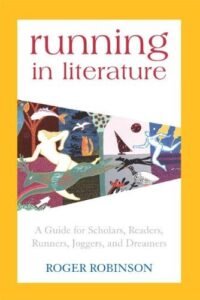
This is a jewel that any book-loving and/or history-loving runner should read
As the sport of pedestrianism developed during the late 18th and early 19th Centuries, we see the publishing of the first running book, in 1813. The author was Walter Thom. As titles of old books usually go, this one, with 32 words on it, is very comprehensive: “Pedestrianism, or an Account of the Performance of Celebrated Pedestrians During the Last and Present Century; With a Full Narrative of Captain Barclay’s Public and Private Matches and an Essay on Training”. Quite a mouthful.
As we approach our times, and especially the Post WWII years when the access to literature and affordability of books became common, and as the first and second running booms arrived, a wide array of novels, poems, magazines and books came to market, some with much success, enough to become cult classics. Later, as the running scene exploded, more and more runners wanted to delve into de minutiae of the sport, its history, its science and the insight only the highest performers could offer through their memoires, so non-fiction and history books started showing up on the shelves.
The author dedicates chapters to the best fiction and non-fiction running books, and offers a short, personal review on each one of his selections. These are good recommendations for anyone wanting to dig deeper into the history and/or literature of our sport.
This is a very comprehensive book that covers over 3000 years of literature, so it is full of references and a collection of rotating protagonists that makes it very dense. This is not a pejorative reference on the book, just a warning so you will take your time to read it and digest it properly. This way you can get the most enjoyment and benefit from your time with this jewel that any book-loving and/or history-loving runner should read.









